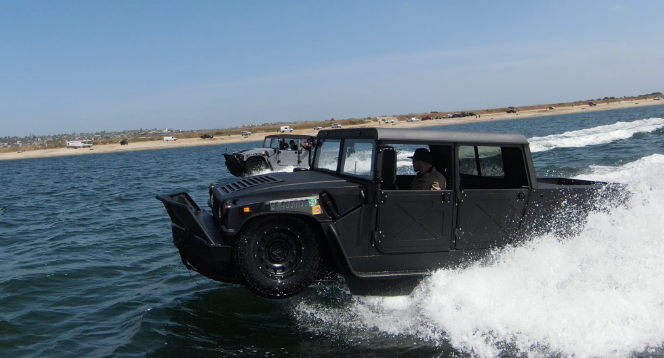Watercar, an automobile company specialised in producing waterways which runs on land and water; launches the most versatile car ever—the H-1 Panther.
The H1-Panther is dubbed the most versatile vehicle that has ever been conceived of. This is WaterCar’s fifth generation of their amphibious vehicle, and it’s also their most advanced model to date. Designed to perform exceptionally well in the harshest environments, including the most demanding water conditions and the most rugged terrain.
The H1-Panther challenges the limits of what is thought to be feasible. It is a genuine amphibious all-terrain utility vehicle that is capable of travelling at highway speeds and can maintain a cruising speed of 35 knots when operating on water.
It is also created with inspiration from the HMMWV. The HMMWV, pronounced as the Humvee, is the most suitable foundation platform. It is capable of traversing deep water and navigating the hardest terrain thanks to its over 30 years of documented history of surviving the most challenging situations. The Humvee is a unique vehicle in comparison to others.
The H1-Panther is the best of WaterCar’s production and it moves at a speed of 75 mph on land and 45 mph on water. It is worth about half a million dollars.
Read also: Proforce Nigerian-Built Armoured Vehicles Make Waves
Why H1-Panther was Created
The Humvee serves as the foundation for the H1-Panther, which is built out of high-strength aluminium and is significantly more durable than fibreglass. In the past, amphibious vehicles that were propelled by jet engines would fail to function properly in water that included debris.
The newly designed model required a propulsion system that was strong enough to power it through the wreckage. It was an absolute requirement that it had four-wheel drive and sufficient ground clearance for off-roading, in addition to a vee in the hull that was sufficiently deep to handle choppy seas.
It needed to have an optional top and complete doors, a decent heater, and air conditioning as an option. Additionally, it needed to be able to work in all conditions. It was required that the vehicle be able to fit inside of a container that was 20 feet in length so that it could be transported anywhere in the world.
All of this was a difficult request to fulfil, considering that the majority of amphibious vehicles typically end up being poor-driving cars and terribly performing boats due to the numerous engineering compromises that need to be made in order to construct a vehicle that is capable of driving on the water.
Challenges WaterCar crew faced during H1-Panther’s production
The team has more than 20 years of experience, and despite all of their previous triumphs and setbacks, this particular project proved to be by far the most difficult one they have ever undertaken.
The ultimate result demonstrates the WaterCar team’s level of expertise as well as their dogged determination. The four-wheel-drive H1-Panther can go at highway speeds on land and 35 knots on water, and it can make the transfer from land to water in less than 20 seconds.
The chassis is made of high-strength aluminium and features an advanced design that allows it to function effectively in a variety of challenging environments. We make use of the most long-lasting and robust components that are accessible.
Even though it has features such as a gigantic prop made of stainless steel that is able to run in the dirtiest water and low range 4×4 huge mud tyres, it is nevertheless able to be driven down the highway without any discomfort.
The H1-Panther is a genuine amphibious utility vehicle that is capable of being utilised in the harshest of environments. The H1-Panther is head and shoulders above any other amphibious vehicle that has ever been constructed to this day.
















